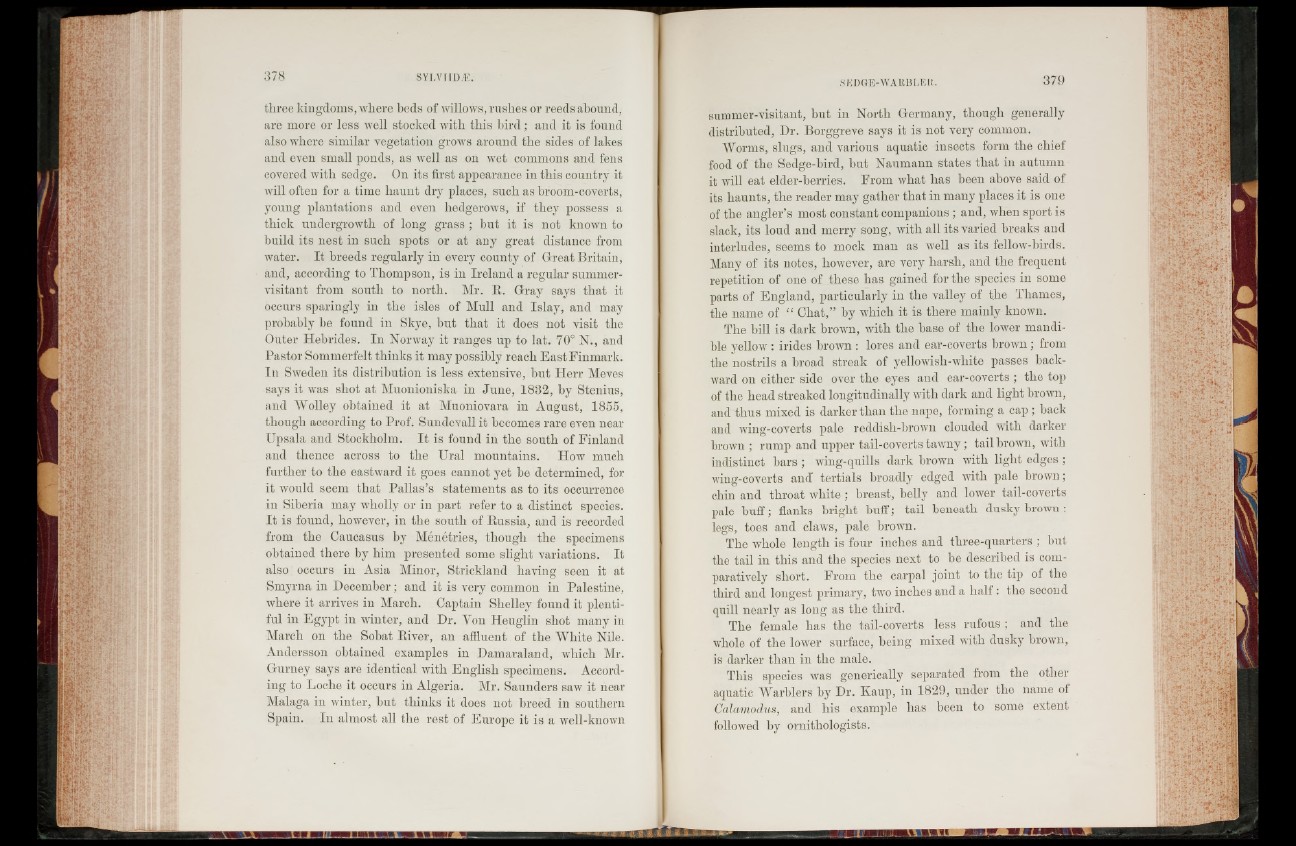
three kingdoms, where beds of willows, rashes or reeds abound,
are more or less well stocked with this b ird ; and it is found
also where similar vegetation grows around the sides of lakes
and even small ponds, as well as on wet commons and fens
covered with sedge. On its first appearance in this country it
will often for a time haunt dry places, such as broom-coverts,
young plantations and even hedgerows, if they possess a
thick undergrowth of long g ra s s ; but it is not known to
build its nest in such spots or at any great distance from
water. It breeds regularly in every county of Great Britain,
and, according to Thompson, is in Ireland a regular summer-
visitant from south to north. Mr. R. Gray says that it
occurs sparingly in the isles of Mull and Islay, and may
probably be found in Skye, but that it does not visit the
Outer Hebrides. In Norway it ranges up to lat. 70° N., and
Pastor Sommerfelt thinks it may possibly reach EastFinmark.
In Sweden its distribution is less extensive, but Herr Meves
says it was shot at Muonioniska in June, 1832, by Stenius,
and Wolley obtained it at Muoniovara in August, 1855,
though according to Prof. Sundevall it becomes rare even near
Upsala and Stockholm. I t is found in the south of Finland
and thence across to the Ural mountains. How much
further to the eastward it goes cannot yet be determined, for
it would seem that Pallas’s statements as to its occurrence
in Siberia may wholly or in part refer to a distinct species.
I t is found, however, in the south of Russia, and is recorded
from the Caucasus by Menetries, though the specimens
obtained there by him presented some slight variations. It
also occurs in Asia Minor, Strickland having seen it at
Smyrna in December; and it is very common in Palestine,
where it arrives in March. Captain Shelley found it plentiful
in Egypt in winter, and Dr. Von Heuglin shot many in
March on the Sobat River, an affluent of the White Nile.
Andersson obtained examples in Damaraland, which Mr.
Gurney says are identical with English specimens. According
to Loche it occurs in Algeria. Mr. Saunders saw it near
Malaga in winter, but thinks it does not breed in southern
Spain. In almost all the rest of Europe it is a well-known
summer-visitant, but in North Germany, though generally
distributed, Dr. Borggreve says it is not very common.
Worms, slugs, and various aquatic insects form the chief
food of the Sedge-bird, but Naumann states that in autumn
it will eat elder-berries. From what has been above said of
its haunts, the reader may gather that in many places it is one
of the angler’s most constant companions; and, when sport is
slack, its loud and merry song, with all its varied breaks and
interludes, seems to mock man as well as its fellow-birds.
Many of its notes, however, are very harsh, and the frequent
repetition of one of these has gained for the species in some
parts of England, particularly in the valley of the Thames,
the name of “ Chat,” by which it is there mainly known.
The bill is dark brown, with the base of the lower mandible
yellow : irides brown : lores and ear-coverts brown ; from
the nostrils a broad streak of yellowish-white passes backward
on either side over the eyes and ear-coverts ; the top
of the head streaked longitudinally with dark and light brown,
and thus mixed is darker than the nape, forming a cap ; back
and wing-coverts pale reddish-brown clouded with darker
brown ; rump and upper tail-coverts tawny; tail brown, with
indistinct bars ; wing-quills dark brown with light edges ;
wing-coverts and tertials broadly edged with pale brown;
chin and throat white ; breast, belly and lower tail-coverts
pale buff; flanks bright buff; tail beneath dusky brown :
legs, toes and claws, pale brown.
The whole length is four inches and three-quarters ; but
the tail in this and the species next to be described is comparatively
short. From the carpal joint to the tip ol the
third and longest primary, two inches and a half : the second
quill nearly as long as the third.
The female has the tail-coverts less rufous ; and the
whole of the lower surface, being mixed with dusky brown,
is darker than in the male.
This species was generically separated from the other
aquatic Warblers by Dr. Kaup, in 1829, under the name of
Calamodus, and his example has been to some extent
followed by ornithologists.